1993 CHEVROLET CORVETTE automatic transmission
[x] Cancel search: automatic transmissionPage 58 of 370
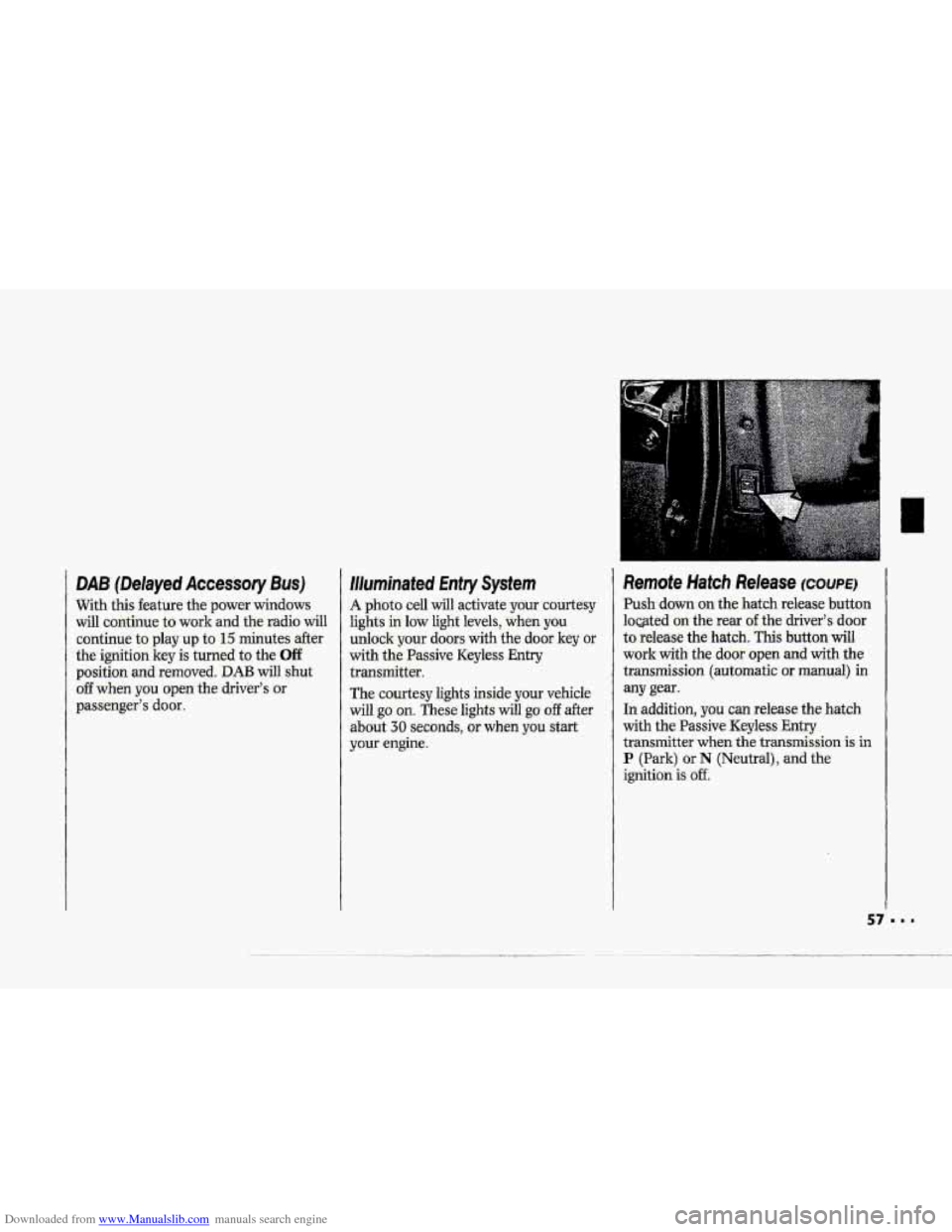
Downloaded from www.Manualslib.com manuals search engine DAB. (Delayed Accessory Bus)
With this feature the: power windows
will continue to work and the radio will
continue
to play .up,to 15 minutes after
the ignitiorikey is turned to the Off
position and: removed. DAB will shut
off when you open the ,driver’s or
passenger’sdoor.
illuminated Entry System
A photo cell will activate your :courtesy
lights in low light levels, when you
unlock your do-ors with the door key or
with the Pawive Keyless Entry
,transmitter.
The courtesy lights inside your vehicle
will
go on. These lights will go off after
about 30 seconds, or when you start
your engine.
Remote Hatch Release COUPE^
Push-down. on the hatch release button
loated
on the rear ofthe driver’s door,
to release the hatch. This button will
work with the dooi. open and with the
transmission (automatic
ar manual) in
any gear.
In addition, YQU can release the hatch
with the Passive Keyless
Entry
transmitter when the transmission is.. in
P (Park) or N (Neutral), and the
ignition
is off.
Page 59 of 370
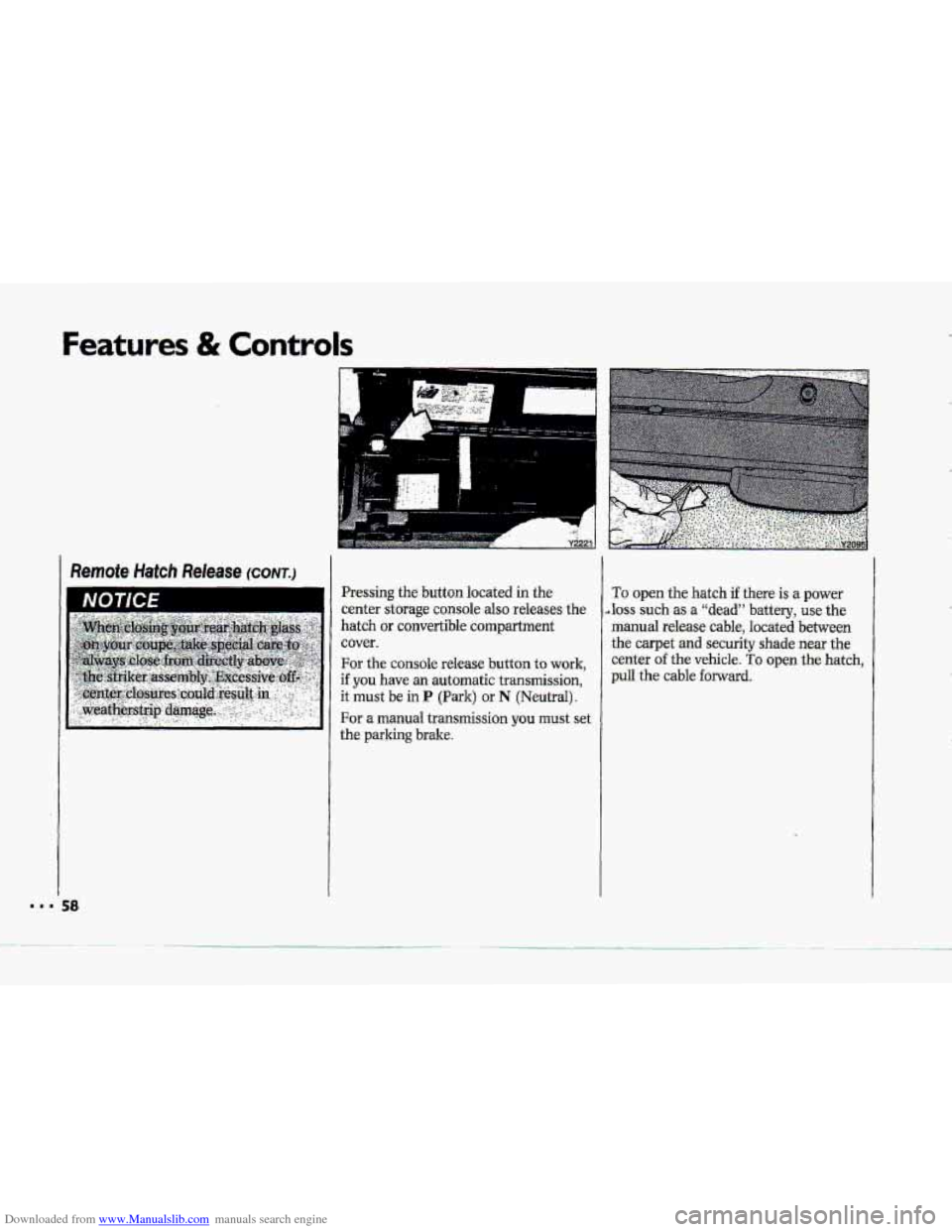
Downloaded from www.Manualslib.com manuals search engine Featurc ; & Controls
Remote Hatch Release (CONT.)
Pressing the button located in the
center
storage console also releases the
hatch
or qmvgdjble c;ompartment
cover.
For the console release button to work,
if you have an automatic transmission,
it must be in P (P.a-1~) or N (Neutral).
For a manual transmission you must set
the parking. brake.
To open the hatch if there is a power
.loss such as a "dead" battery, use the
manual release cable, located between
the carpet and security shade near .the
center of the vehicle. To open the hatch,
pull the cable forward.
Page 61 of 370
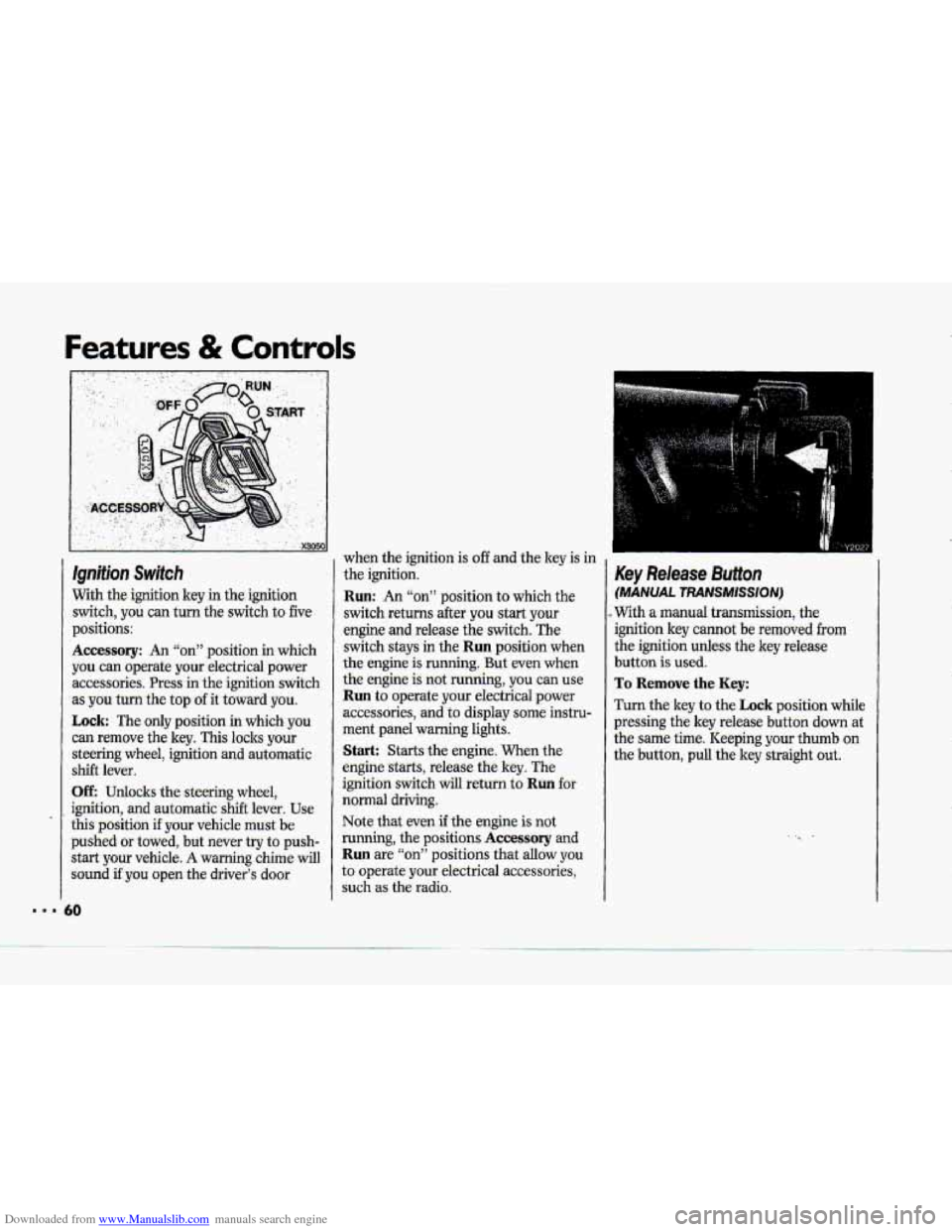
Downloaded from www.Manualslib.com manuals search engine Features & Controls
Ignition Switch
With the-ignition key in the ignition
switch, you can turn
the switch to five
p.ositions:
Accessory: An “on” position in which
you
can operate your .electrical power
accessories. Press in the-ignition .switch
as
you turn the top of it toward you.
Lock: The only position in which you
can remove the key. This locks your
steering wheel, ignition. and automatic
shift lever.
UE Udo:cks the steering wheel,
ignition, and automatic shift lever. Use
this pasition if your vehicle must be
pushed or towed, but never try to push-
start your vehicle-.
A warning chime will
sound if you open the driver’s door when
the ignition is
off and the key is in
the ignition.
Run: An “on” position to which the
switch returns after you start your
engine and release the switch. The
switch stays in
the Run position when
the engine is running. But -even when
the engine is-not running, you can use.
Run to operate your electrical power
accessories,
and to display some instru-
ment panel warning lights.
Start: Starts the engine, When the
engine starts, release the key. The
ignition switch will return to
Ruil fot
noma1 driving.
Note
that even if the engine is not
running, the positions
Accessory and
Run are “on” positions that allow y0.u
to operate your electrical accessories,
such
as the radio.
Key Release Button
(MANUAL TRANSMISSION)
..With a manual transmission, the
ignition key c-ot be removed from
the ignition unless the key release
button is used.
To Remove the Key:
Turn the key to the Lock position while
pressing the
key release buttoa down at
the same time. Keeping your thumb on
the button, pull the key straight out.
Page 63 of 370
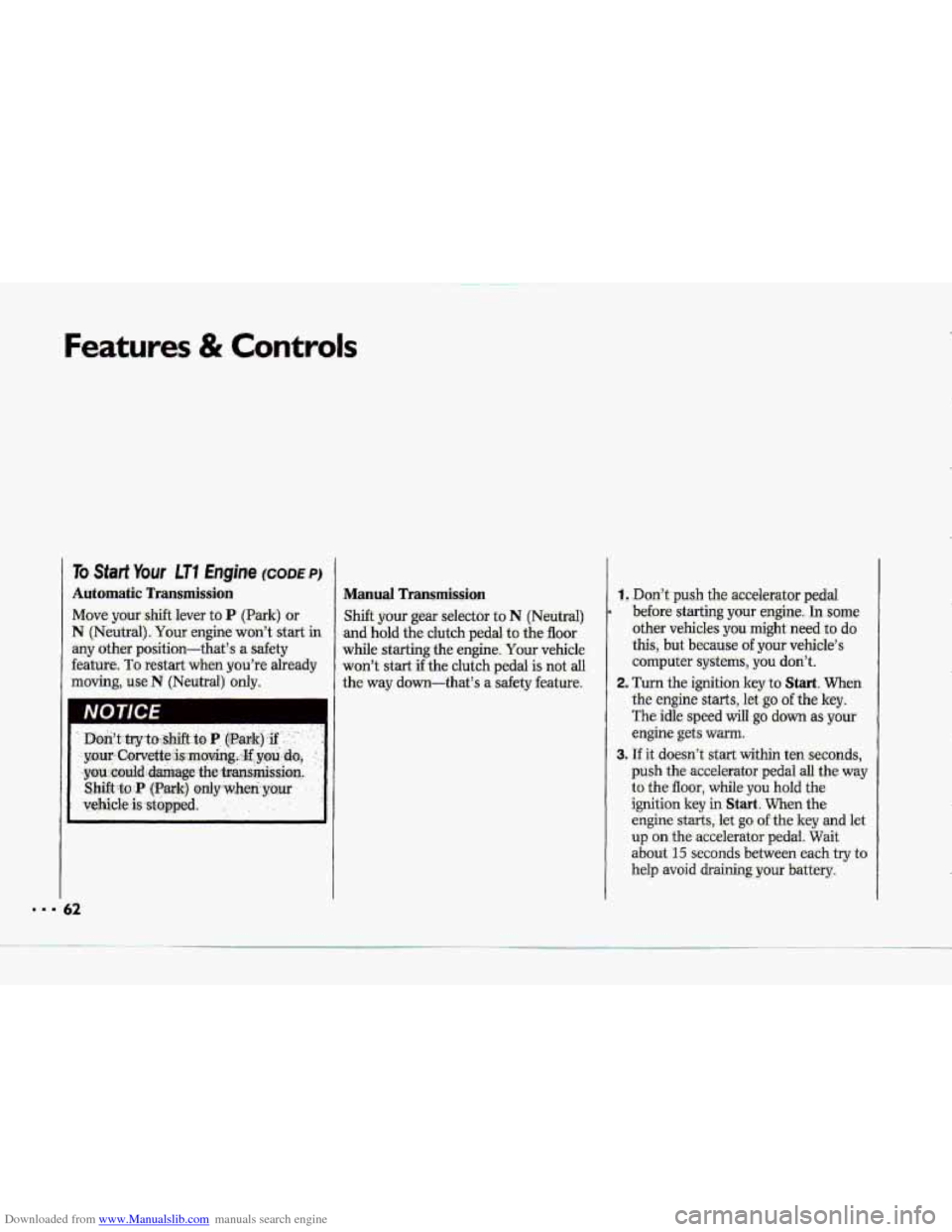
Downloaded from www.Manualslib.com manuals search engine Features & Controls
To Start Your fT7 Engine (CODEPI
Automatic Transmission
Move yaur,xhift.lever to P (Park) or
N (Neutral). Your engine won’t start in
any other position-that’-s -a sdety
feature. TO restart when you’re already
moving, use.N (Neutral) only.
i2
Manual Transmission
Shift your gear selector to N (Neutral)
md hold the clutch pedal tu the floor
while starting-the engine.
.Your vehi.cle
won’t start if the clutch pedal is not aIl
the way down-that’s a safety feature.
1, Don’t push the accelerator pedal
before
starting your engine. In s~me
other ve.hicles you might need to do
this, but because of your vehicle’s
Computer systems,
you don’t.
2. Turn the ignition key.ta Start. When
the engine starts,
let go of the key.
The idlespeed wiil go down as-your
engine
gets warm.
3. If it doesn’t start within ten-seconds,
push the-accelerator pedal all the way
to the;floor, while you hold the
ignition
key in Start. When the
engine starts, let go ofthe key and let
up on.the accelerator ped.4. Wait
abaut .15 seconds between each.try to
help -avoid draining your battery. --
Page 68 of 370
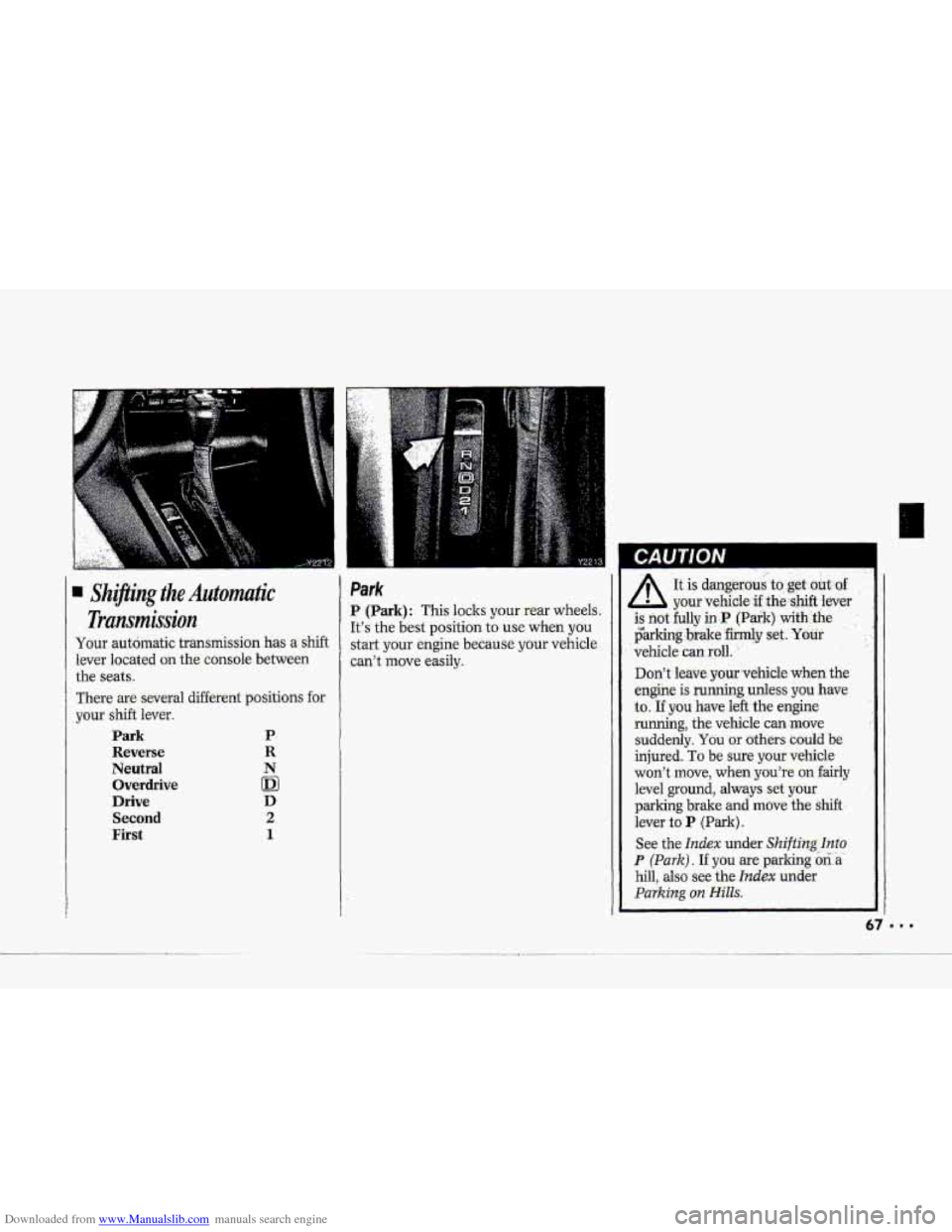
Downloaded from www.Manualslib.com manuals search engine 9 Shifting the Automatic
Transmission
Your automatic transmission has a shift
-lever located on the console- between
the seats.
There
sire several different positions for
your shift lever.
Park
Reverse
Neutral
Overdrive
Drive
Second
First
P -
D
D
2
1
Park
P (Park): This loclts your rear wheels.
It’s the
best position to use when you
start your engine because your vehicle
can’t move easily.
CAUTION I
It is dangerous to,:get oui:-af :
your ‘vehicle -3 th&hift lever
is not fully in P (Park) ,with the
p”arkinglbrdce~My set. your
vehicle :can roll. ’
Don’t leave your,vehicle when the
engine is running unless you have
to. If you have left the engine
running, the vehicle can -move
suddenly.
You or ,others could be
injured. To be sure your vehicle
won’t move, when you”re
on fairly
level ground, always set. your
parking brake and move the shift -
lever to P -(Park).
See the
Index under Shifting Into
hill, also see the Index under
Parking on Hills.
P (Park). If you are parking 0ri:a.
Page 70 of 370
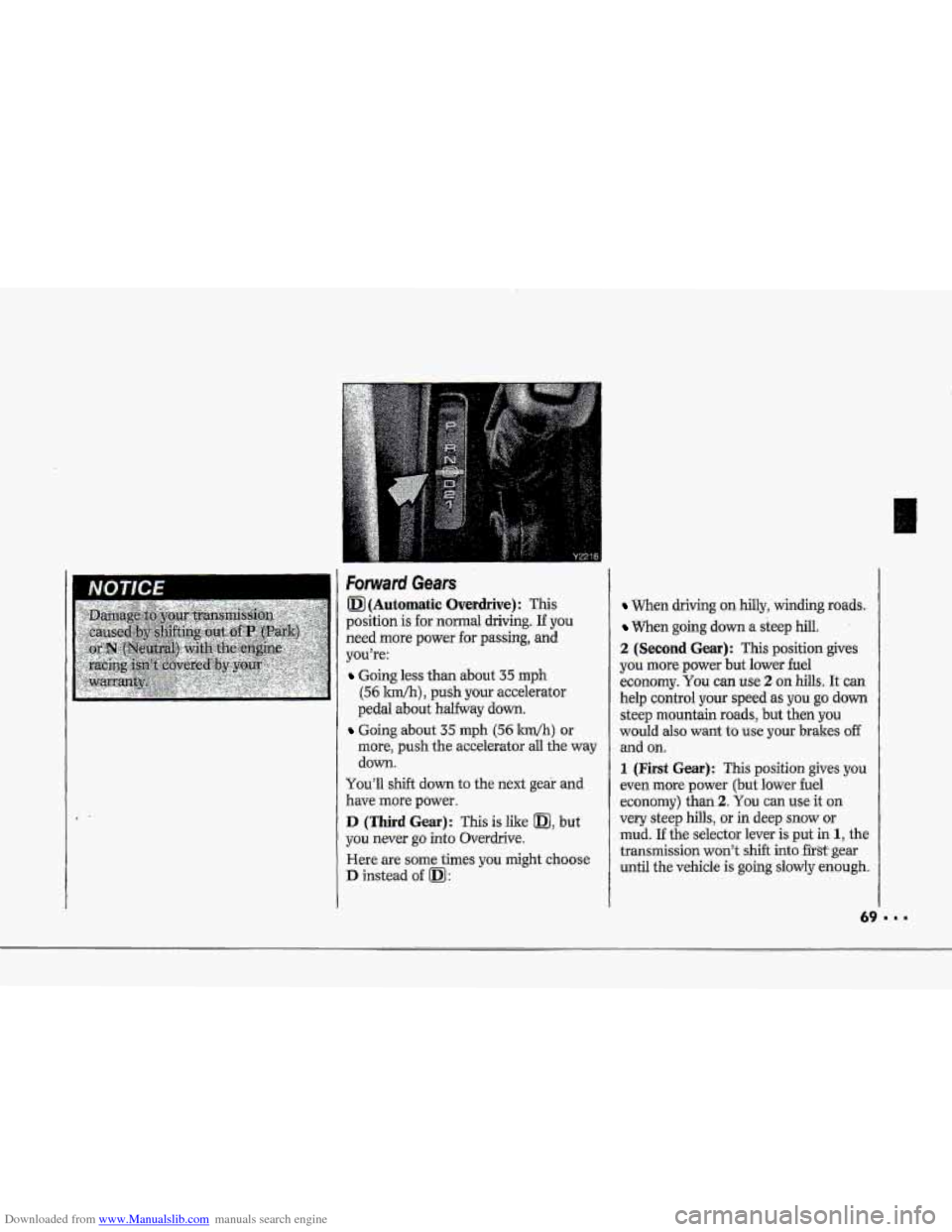
Downloaded from www.Manualslib.com manuals search engine Forward Gears I
0 (Automatic Overdrive): This
position is. for normal driving. If you
need more power for passing, and
you're:
Going less than about 35 mph
(56,lUn/h), push your accelerator
pedal
about halfway down.
Going about 35 mph (56 ldh) or
more, push the accelerator all .the way
down.
You'll shift down to the next geai and
have more power.
D (Third Gear): This is like m, but
you never go into Overdrive.
Here-are
some times you might choose
D instead of a:
When driving on hilly, winding roads.
When going down a steep hill.
2 (Second Gear): This position gives
you more. power but lower -fuel
economy.
You can use 2 on hills. It can
help control your speed as yuu go down
steep mountain roads, but then you
would also want to use your brakes off
and on..
1 (First Gear): This position gives you
even more power (but lower fuel
economy)
than 2. You can use it on
very steep hills, 01 in deep snow or
mud. If
the selector lever is put in 1, the
transmission won't shift into first- gear
until the vehicle is going slowly enough.
Page 79 of 370
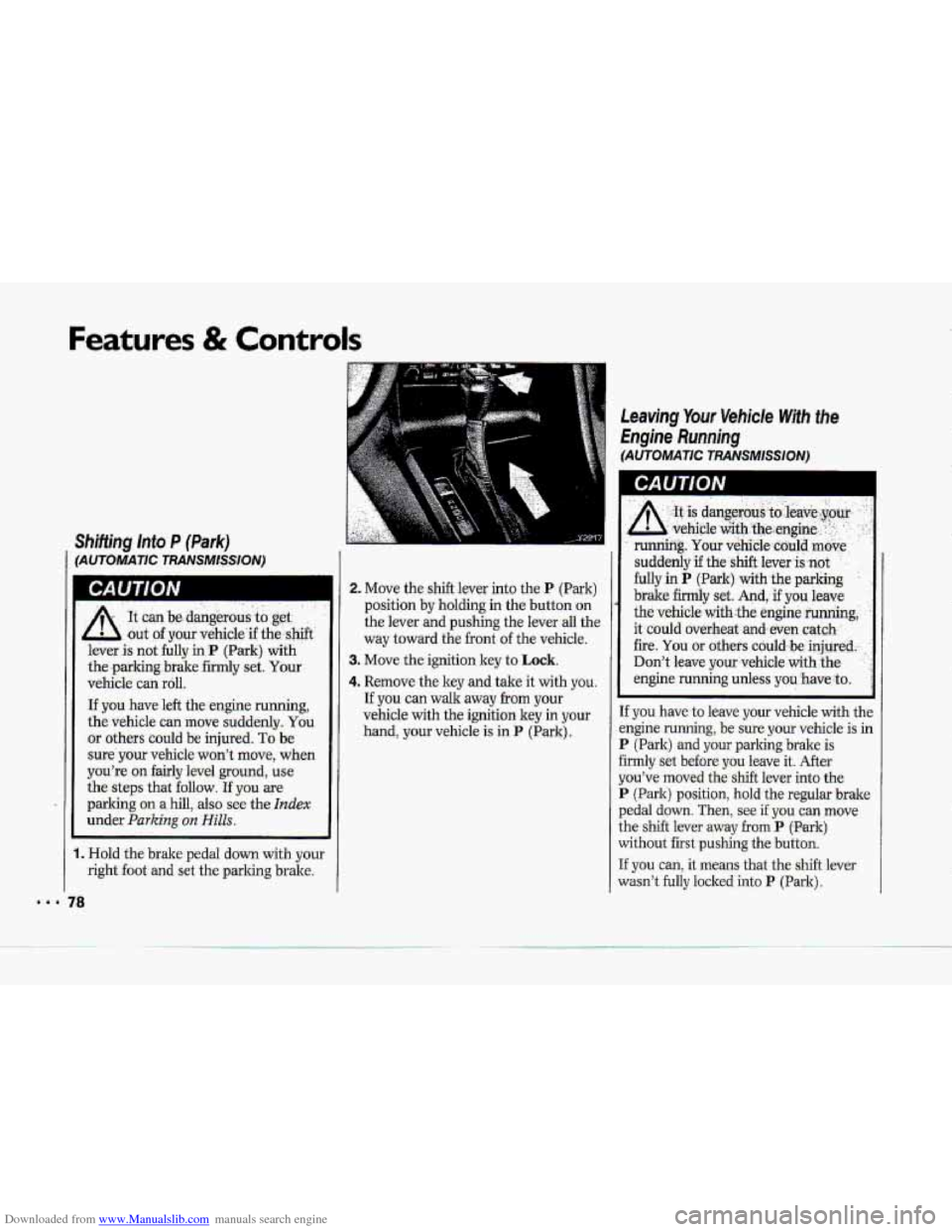
Downloaded from www.Manualslib.com manuals search engine Features & Controls
., ,.,.. -
:It can be, dangerous.iu.get: '
.. ..
:out- of .your vehicle'if the: shift
lever is nut fully in P (Park) with
the -parking .brake firmly set.
Your
vehicle can roll,
If you have left the engine. running,
the vehicle can move suddenly. You
.or others could be injured. To be
sure' your vehicle won't move, when
you're on fairly level ground, use
the
steps that follow. If you are
parking on
a hill, also see the Index
under Parking on Hills.
1. Hold the bralre pedal down with your
right foot and set the p-arlting
brake.
2. Move the shift lever into the P (Park)
position
by holding in the button on
the lever and pushing t-he 1ever.all the
way toward the front of the vehicle.
3. Move the ignition key to Lock.
4. Remove the key and take it with YOU.
If you can walk away from your
vehicle with the ignition key in your
hand, your vehicle
is in P (Park).
Leaving Your Vehicle With the
Engine
Running
(AUTOMATIC TRANSMISSION)
If you have-to leave your vehicle with the
engine
running, be sure your vehicle is in
P (Park) and your parking brake is
firmly set be€ore you leave it. After
you've moved the shift lever into the-
P (Park) position, hold the regular brake
pedal
down. Then, see if you can move
the shift lever away from P (.PC&)
without first pushing the button.
If you can, it means that the shift lever
wasn't
fully lockdinto P (Park).
Page 81 of 370
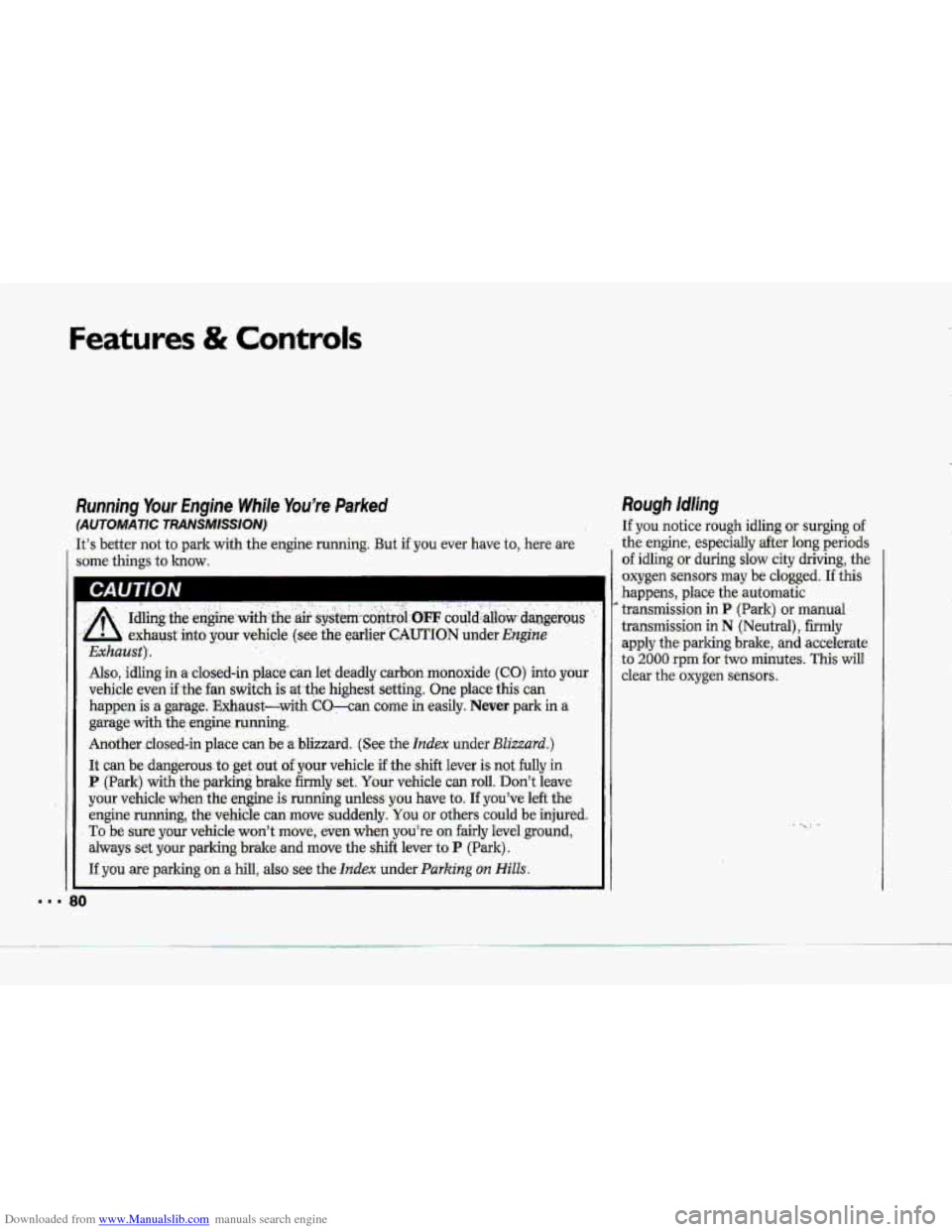
Downloaded from www.Manualslib.com manuals search engine Features & Controls
Running Your Engine While You're Parked
(AUTOMATIC TRANSMISSION)
It's better not to park.with the engine running. But if.you ever have to, here !are
some things to know.
'Exhaust)-.
Also, idring in a: closed-in-place -c'm let..deadly carbon monoxide (CO) into your
vehicle even %$he fan switch
is at.the highest setting. One place this can
happen'
is :a garage.. 'Exhaust-wiih CO-can corne heady. Never park in a
garage-with.fhe engine
running.
.Another closed-in place can be a blizzard. (See the Index under.BZizzai.d.)
It dan'b.e .dangerous.
to get .out of your vehicle if the shift lever is not fully in
P (Park) with:ihe.parking brake firmly set. Your vehicle can roll. Don't leave
your vehicle whenthe engine
is running unless you have to. If you've left the
engine running, the-.vehicle can move suddenly.
You or others. could be injured.
To be su-re your vehicle won't.move, even when you'-re on fairly level-ground,
aiways set
your .parking-brake and move the shift lever to P (Park).
If you are parking on .a hill, also. see the Index under Parking on Hi'ZZs.
Rough Idling-
If you notice rough idling or surging of
the engine, especially after long periods
of idling;.or during slow city driving, the
oxygen sensors
may be clogged. If this
happens, place the automatic
' transmission in P- (Park) .or manual
transmission in
N (Neutral), firmly
apply the parlcing brake, and accelerate.
to
2000 rprn for two minutes. This will
clear the oxygen sensors,
80